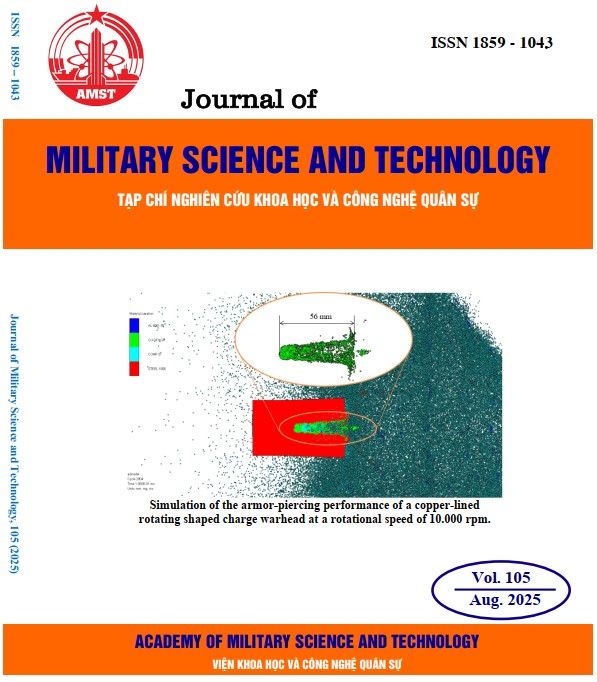Effect of some factors on the electrolysis production of sodium perchlorate from sodium chlorate using PbO2/Pb-Ti electrode
480 viewsDOI:
https://doi.org/10.54939/1859-1043.j.mst.105.2025.90-97Keywords:
Sodium perchlorate; Electrolysis; Sodium chlorate; PbO2 electrode.Abstract
The electrolysis process of sodium perchlorate production from sodium chlorate using PbO2/Pb-Ti electrode was studied by linear sweep voltammetry (LSV), electrochemical impedance spectroscopy (EIS) and electrolysis efficiency evaluation. The results showed that the technological parameters (sodium chlorate concentration, temperature, electrolyte current density, additive content and pH) strongly affected the polarization, charge transfer resistance and electrolysis efficiency. Therefore, the appropriate technological mode for the electrolysis process was selected as: NaClO3 concentration 300 - 600 g/L; temperature 50 oC; current density 0.15 - 0.2 A/cm2; NaF additive concentration 1-2 g/L; solution pH 7.
References
[1]. T. Chongcheng, Y. Pei, “Method for producing sodium perchlorate”, Patent CN 1012742B, (1991).
[2]. Henry C. Miller, John C Grigger, “Method of producing perchlorates”, Patent US2813825A, (1957).
[3]. Javier Llanos et al., “Electrochemical production of perchlorate as an alternative for the valorization of brines”, Chemosphere, Vol. 220, pp. 637-643 (2019). DOI: https://doi.org/10.1016/j.chemosphere.2018.12.153
[4]. Ahmed D. Wiheeb, “The manufacture of perchlorate by direct method using graphite substrate lead dioxide (Gsld) anode”, Diyala Journal of Engineering Sciences, Vol. 2(1), pp. 66-79 (2009). DOI: https://doi.org/10.24237/djes.2009.01105
[5]. Jean-Christophe Millet, Michel Jaccaud, “Continuous electrolytic production of alkal metal perchlorates”, Patent US 5004527, (1991).
[6]. Handady V. K. Udupa et al., “Electrolytic preparation of perchlorate”, Patent US3493478, (1970).
[7]. M. Cheraghveisi et al., ”Electrosynthesis of perchlorate using neodymium-doped PbO2 electrode: application of experimental design methodology for optimization of the effective parameters”, Materials Research Express, Vol. 9(2), pp. 1-10 (2022). DOI: https://doi.org/10.1088/2053-1591/ac5551
[8]. Sai Bhavaraju, James Steppan, “Bismuth metal oxide pyrochlores as electrode materials”, Patent EP 2443269A2, (2012).
[9]. A. Sánchez-Carretero et al., “Electrochemical production of perchlorates using conductive diamond electrolyses”, Chemical Engineering Journal, Vol. 166(2), pp. 710-714, (2011). DOI: https://doi.org/10.1016/j.cej.2010.11.037
[10]. L. J. J. Janssen, P. D. L. Van Der Heyden, “Mechanism of anodic oxidation of chlorate to perchlorate on platinum electrodes, Journal of Applied Electrochemistry”, Vol. 25 (2), pp. 126 – 136, (1995). DOI: https://doi.org/10.1007/BF00248169
[11]. Takashi Osuga, Shojiro Fujii, Kiichiro Sugino, Taro Sekine, “Electrolytic production of perchlorate by lead dioxide anodes”, Journal of The Electrochemical Society, Vol. 116 (2), pp. 203 -207, (1969). DOI: https://doi.org/10.1149/1.2411796
[12]. Joseph C. Schumacher et al., “Electrolytic production of Sodium perchlorate using Lead dioxide anodes”, Journal of The Electrochemical Society, Vol. 105 (3), pp. 151, (1958). DOI: https://doi.org/10.1149/1.2428781
[13]. Rossano Amadelli, A. B. Velichenko, “Lead dioxide electrodes for high potential anodic processes”, Journal of the Serbian Chemical Society, Vol. 66 (11-12), pp. 835-845 (2001). DOI: https://doi.org/10.2298/JSC0112835A
[14]. M. Munichandraiah et al., “Kinetics and mechanism of anodic oxidation of chlorate ion to perchlorate ion on lead dioxide electrodes”, Journal of Applied Electrochemistry, Vol. 17, pp. 33-48, (1987). DOI: https://doi.org/10.1007/BF01009129
[15]. Z. Chen et al., “A novel Pb/PbO2 electrodes prepared by the method of thermal oxidation-electrochemical oxidation: Characteristic and electrocatalytic oxidation performance”, Journal of Alloys and Compounds, Vol. 851, pp. 156834, (2021). DOI: https://doi.org/10.1016/j.jallcom.2020.156834







